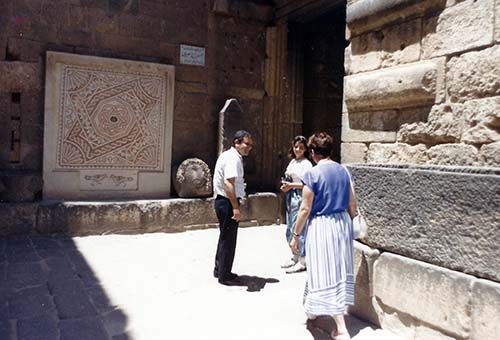Looking through stacks of old pictures today, I came across a set I shot in Bosra, Syria, 23 years ago showing stately, if worn, internationally recognized relics.
Then I was jolted forward to this year when I read and saw reports of those same historical jewels being hit by warring factions in the country's two-plus-year civil war.
The bombing raised red flags by UNESCO, which had featured Bosra as a World Heritage Site.
The organization's experts were alarmed by the heavy damage inflicted on the city, prompting UNESCO to add it to its list of endangered sites.
Back then, history hounds like me seeking ancient ruins had to be hardy adventurers willing to suffer discomfort along neglected roads in a VW Beetle winding through the country's south to reach Bosra, noted as a crossroads for caravans since the First Century A.D.
The only damage we feared was a flat tire in that God-forsaken wilderness.
A seemingly endless drive along a highway then funded by the U.S. Agency for International Development narrowed into a smaller throughway with few, if any, signs to indicate a traveler was on the right track.
In remote villages, residents of the Houran region may or may not have been able to point a tourist in the right direction towards Dara'a further west, where the current Syrian unrest erupted over two years ago.
Ironically, it was at Dara'a where the Arab revolt against the Turks led by T.E. Lawrence (Lawrence of Arabia) scored a major success at the end of World War I.
Driving past emplacements for decoy surface-to-air missiles over two decades ago, I was startled to stumble upon an entire city that included a Roman cemetery, a hippodrome, Nabatean relics, a Mamluk bath, several mosques, a cathedral, a market, an amphitheater and a castle.
 Entrance to Bosra's famed amphitheater (Abu-Fadil)
Entrance to Bosra's famed amphitheater (Abu-Fadil)
Except for a lone caretaker and his wife at the castle entrance collecting a nominal fee, my companions and I were left to look around freely and imagine what manner of people passed through these hallowed and haunted hallways.
To see it, one could understand why this once-busy city, 141 kilometers (709 miles) from the capital Damascus, and 850 meters (2,788 feet) above sea level, was called Bosra, or fort, in old Semitic inscriptions.
Little information was available on Bosra (also referred to in Arabic as Bosra Al Sham) in the pre-Hellenistic era. Early mentions can be found on tablets uncovered in Egypt's Tal El Amarna region dating back to 14 B.C.
From the writings, scholars determined that cities in the Houran region of modern-day Syria were inhabited primarily by Semitic Arabs as far back as there were records to prove it.
The best-known tribes of the times included the Accadians, the Cananites and the Nabateans.
Bosra grew fast and expanded in the Nabatean era to become a magnet for caravans when the last Nabatean king made it his capital.
But in 105 A.D., the area was attached to the Roman Empire whose rulers turned Houran, the Golan Heights, and eastern Jordan into "The Arab Province," with Bosra as its capital.
The city thrived as a center for architecture, agriculture and commercial prosperity.
A network of roads spread to Amman (Jordan), the Arabian Gulf, Haifa on the Mediterranean, as well as to Damascus and Palmyra - another historic metropolis.
The Byzantine era was no less charged, with wars pitting the Persians against the Arabs and the emergence of the Ghassanide state that boasted the first Christians in the Arabian Peninsula.
Not incidentally, Bosra bishops partook in the synods of Antioch, Constantinople, and Ephesus.
In 634 A.D., Bosra's Arab Christian population fought against the Byzantines and rid Syria of Byzantine shackles, according to documents provided to Syrian historians and archeologists.
The city also featured prominently during the Islamic era and became the site of countless battles in Crusader times.
During those conflicts, city administrators ordered the construction of a castle around Bosra's impressive amphitheater, which turned it into a fortress that held back the attacking Crusaders.
 Bosra's forlorn amphitheater (Abu-Fadil)
Bosra's forlorn amphitheater (Abu-Fadil)
But the marauding Moguls seriously damaged the walls in 1261 A.D.
The ruling governor promptly dispatched construction workers and equipment to rebuild the castle and its protective shield as soon as the invaders had withdrawn.
Although accoustically sound, the site was considered too far from the capital and too ill-equipped some years back to serve as a cultural center.
So what has become of this UNESCO World Heritage Site with its majestic amphitheater encircling a wall and powerful white columns that served as a backdrop for seasonal contemporary musical and theatrical productions?
What of modern-day intruders and combatants?
Will Bosra ever regain some of its glory, or is it doomed to die like the tens of thousands of innocent civilians caught in the midst of a war of somebody else's choosing?
